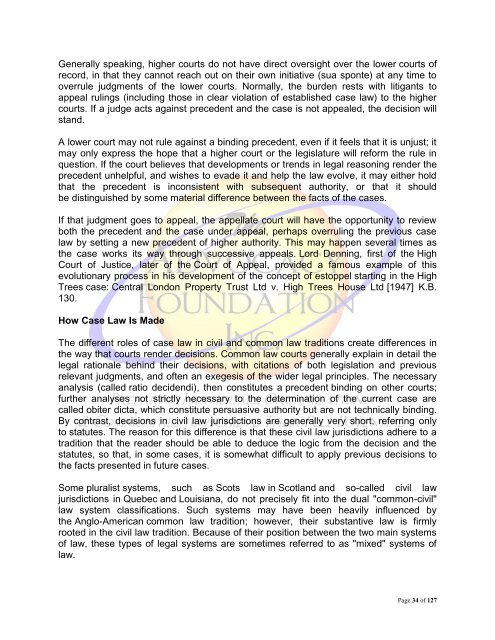Case Law, Statutory Law, Municipal Ordinances & Policy
Case Law, Statutory Law, Municipal Ordinances & Policy
Case Law, Statutory Law, Municipal Ordinances & Policy
You also want an ePaper? Increase the reach of your titles
YUMPU automatically turns print PDFs into web optimized ePapers that Google loves.
Generally speaking, higher courts do not have direct oversight over the lower courts of<br />
record, in that they cannot reach out on their own initiative (sua sponte) at any time to<br />
overrule judgments of the lower courts. Normally, the burden rests with litigants to<br />
appeal rulings (including those in clear violation of established case law) to the higher<br />
courts. If a judge acts against precedent and the case is not appealed, the decision will<br />
stand.<br />
A lower court may not rule against a binding precedent, even if it feels that it is unjust; it<br />
may only express the hope that a higher court or the legislature will reform the rule in<br />
question. If the court believes that developments or trends in legal reasoning render the<br />
precedent unhelpful, and wishes to evade it and help the law evolve, it may either hold<br />
that the precedent is inconsistent with subsequent authority, or that it should<br />
be distinguished by some material difference between the facts of the cases.<br />
If that judgment goes to appeal, the appellate court will have the opportunity to review<br />
both the precedent and the case under appeal, perhaps overruling the previous case<br />
law by setting a new precedent of higher authority. This may happen several times as<br />
the case works its way through successive appeals. Lord Denning, first of the High<br />
Court of Justice, later of the Court of Appeal, provided a famous example of this<br />
evolutionary process in his development of the concept of estoppel starting in the High<br />
Trees case: Central London Property Trust Ltd v. High Trees House Ltd [1947] K.B.<br />
130.<br />
How <strong>Case</strong> <strong>Law</strong> Is Made<br />
The different roles of case law in civil and common law traditions create differences in<br />
the way that courts render decisions. Common law courts generally explain in detail the<br />
legal rationale behind their decisions, with citations of both legislation and previous<br />
relevant judgments, and often an exegesis of the wider legal principles. The necessary<br />
analysis (called ratio decidendi), then constitutes a precedent binding on other courts;<br />
further analyses not strictly necessary to the determination of the current case are<br />
called obiter dicta, which constitute persuasive authority but are not technically binding.<br />
By contrast, decisions in civil law jurisdictions are generally very short, referring only<br />
to statutes. The reason for this difference is that these civil law jurisdictions adhere to a<br />
tradition that the reader should be able to deduce the logic from the decision and the<br />
statutes, so that, in some cases, it is somewhat difficult to apply previous decisions to<br />
the facts presented in future cases.<br />
Some pluralist systems, such as Scots law in Scotland and so-called civil law<br />
jurisdictions in Quebec and Louisiana, do not precisely fit into the dual "common-civil"<br />
law system classifications. Such systems may have been heavily influenced by<br />
the Anglo-American common law tradition; however, their substantive law is firmly<br />
rooted in the civil law tradition. Because of their position between the two main systems<br />
of law, these types of legal systems are sometimes referred to as "mixed" systems of<br />
law.<br />
Page 34 of 127

















